(Sample Material) Online Coaching for CAPF (AC): History of India - "Ancient Indian History (Part - 2)"
Online Coaching for UPSC Central Armed Police Forces (AC) Written Examination
History of India
Ancient Indian History (Part - 2)
The Mauryan Empire
The Mauryan empire was the first and one of the greatest empires that were established on the Indian soil. The growth of Magadha culminated in the emergence, of the Mauryan Empire. Chandragupta Maurya, who founded the empire (321 BCE), extended control as far northwest as Afghanistan and Baluchistan, and his grandson Ashoka, arguably the most famous ruler of early India, conquered Kalinga (present-day coastal Orissa). Chandragupta Maurya was the first ruler who unified entire India under one political unit.
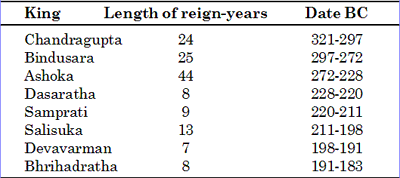
Chandragupta Maurya (321-297 BC)
-
In 305 BC Chandragupta defeated Seleucus Nikator, who surrendered a vast territory. Megasthenese was a Greek ambassador sent to the court of Chandragupta Maurya by Seleucus.
-
He occupied the region north of the Narmada (d) But 305 BC saw him in the campaign against Seleucus Nikator with the treaty of 303 B.C. concluding the war in favour of the Mauryas. By the treaty, Chandragupta made a gift of 500 elephants to Seleucus and obtained the trans-Indus region (the territory across the Indus).
-
Chandragupta became a Jain and went to Sravanbelgola with Bhadrabahu, where he died by slow starvation (Sale/than). Under Chandragupta Maurya, for the first time, the whole of northern India was united. Trade flourished, agriculture was regulated, weights and measures were standardized and money came into use.
-
The Junagarh rock inscription of Rudradaman says that a dam on the Sudarshana lake for irrigation was constructed by Pushyagupta, a provincial governor of Chandragupta Maurya. Later Yavanaraja Tushapha excavated canals for irrigation during Ashoka’s reign.
Bindusara (297-272 BC)
-
Bindusara extended the kingdom further and conquered the south as far as Mysore. Bindusar asked Antiochus I of Syria to send some sweet wine, dried figs, and a Sophist. Antiocus I sent wine and figs but politely replied that Greek philosophers are not for sale. Bindusar patronized Ajivikus.
-
Bindusara, known to the Greeks as “Amitrochates” (derived from the Sanskrit word `Amitraghata’ or slayer of foes), is said to have carried his arms to the Deccan, extending Mauryan control in the peninsu-lar region of India as far south as Mysore.
-
From Divayayadana we come to know that Bindusara appointed his eldest son Sumana (also named Susima) as his viceroy at Taxila and Ashoka at Ujjain. It also tells us that a revolt broke out at Taxila and when it could not be suppressed by Susima, Ashoka was sent to restore peace.
Asoka (268-232 BC)
-
According to the Buddhist tradition, Asoka usurped the throne alter killing his 99 brothers and spared Tissa, the youngest one. Radhagupta a Minister of Bindusar helped him in fratricidal struggle.
-
In 1837 James Prinsep deci-phered an inscription referring to a king called “Devanampiya Piyadas-si”. Later, many more similar inscriptions were discovered. Initially these records could not be attributed to Asoka. But in 1915 was discovered Maski inscription which speaks of Asoka Piyadassi.
-
There was a struggle for the throne among the princes on the death of Bindusara. This war of succession accounts for the interregnum of four years (272-268 BC), and only after securing his position on the throne, Asoka had himself formally crowned in 268 BC.
-
Under Asoka. the Mauryan Empire reached its climax. For the first time, the whole of the subcontinent, leaving out the extreme south, was under imperial control. Asoka (ought the Kalinga war in 261 BC in the 9th years of his coronation. The king was moved by massacre in this war and therefore abandoned the policy of physical occupation in favour of policy of cultural conquest. In oilier words, Bherighosha was replaced by Dhammaghosha.
-
Ashoka is the first king in the Indian history who has left his records engraved on stones. The inscriptions on rocks are called Rock Edicts, and those on Pillars, Pillar Edicts. The Ashokan inscriptions are found in India, Nepal, Pakistan and Afghanistan. Altogether, they appear at 47 places.
-
However, the name of Ashoka occurs only in copies of Minor Rock Edict I found at three places in Karnataka and one in Madhya Pradesh. Ashoka name is mentioned in only four places- Gurjara, Udgolan, Maski, and Nittur.
-
The inscriptions of Ashoka were written in four different scripts. In Afghanistan area they were written in Greek and Aramaic languages and scripts, and in Pakistan area, in Prakrit language and Kharosthi script. Inscriptions from all other areas are in Prakrit language, written in Brahmi script.
-
Asoka sent missionaries to the kingdoms of the Cholas and the Pandyas, and five States ruled by Greek kings. We also know that he sent missionaries to Ceylon and Suvarnabhumi (Burma) and also parts of South East Asia.
-
According to tradition, Asoka built the city of Srinagar. The Mauryans had closed connections with the area of modern Nepal. One of Asoka’s daughters married a noble from Nepal. The Ceylone ruler, Tissa, modelled himself on Asoka.
-
The most important event of Asoka’s reign seems to have been his victorious war with Kalinga (260 BC). Bhabru inscription, states that after a period of 2 1/2 years he became an ardent supporter of Bud-dhism under the influence of a Buddhist monk, Upagupta.
-
The find of Ashokan inscriptions at Girnar hills in Junagarh district (in Gujarat) and at Sopara (Thane district, Maharashtra) shows that these areas formed part of the Mauryan empire.
-
Ashoka’s inscriptions have been found at Maski Yerragudi and Chitaldurga in Karnataka. Rock Edict II and XIII of Ashoka mentions that his immediate neighbouring states were those of Cholas, Pandyas, Satyaputras and Keralaputras.
Asoka’s Dhamma
-
Asoka’s Dhamma cannot be regarded as sectarian faith. Its broad objective was to preserve the social order it ordained that people should obey their parents, pay respect to Brahmanas and Buddhist monks and show mercy to slave and servants.Asoka’s Dhamma was neither a new religion nor a new philosophy. Rather it was a way of life, conduct and a set of principles to be practised by the people at large.
-
The message of Dhamma was propagated in Aramaic and Greek in the north-western borderland of the subcontinent. On the other hand, the emperor chose to issue a large number of edicts in Prakrit in Brahmi script for areas in the Deccan which must have been better acquainted with Dravidian languages.
-
The Kandahar Greek edict, the contents of which have considerable similarities with and correspondence to REs XII and XIII, enlists the virtues to be inculcated by people for practising Eu’sebeia, i.e. Dhamma.
-
Though Ashoka accepted Buddhism as his main faith, it would be wrong to think that he forced Buddhist ideals on his subjects. He showed respect to all sects and faiths and believed in unity among ethical and moral values of all sects.
-
In Rock Edict VII he says, “All sects desire both self control and purity of mind”. In Rock Edict XII he pronounces his policy of equal respect to all religious sects more clearly. He says, that he “honours all sects and both ascetics and laymen, with gifts and various forms of recognition.”
-
Pillar Edict II Ashoka himself puts the question: “What is Dhamma?” Then he enumerates the two basic attributes or constituents of Dhamma less evil and many good deeds. He says such evils as rage, cruelty, anger, pride and envy are to be avoided and many good deeds like kindness, liberality, truthfulness, gentleness, self control; purity of heart, attachment to morality, inner and outer purity etc. “ are to be pursued vigorously.
-
While different Major Rock Edicts talk about different aspects of the Dhamma, the Major Rock Edict XI contains an elaborate explanation of the Dhamma. The following are the main features of the Dhamma:
- Prohibition of animal sacrifices and festive gatherings (M.R.E-I), and avoiding expensive and meaningless ceremonies and rituals (M.R.E-IX);
- Efficient organisation of administration (M.R.E-VI) in the direction of social welfare (M.R.E-II);
- Consideration and non-violence to animals and courtesy to relations (M.R.E-IV) and liberality to Brahmins, Sramanas, etc. (M.R.E-III);
- Humane treatment of servants by masters and of prisoners by the government (M.R.E-V) it also mentions the appointments of Dhamma-Mahamatras;
- Tolerance among all the sects (M.R.E-VII &II) (6) Replacement of ‘Bherighosa’ (sound of wardrums) ‘Dhammaghosa’ (sound of peace) i.e. conquest through Dhamma instead of rough war (M.R.E-XIII);
- Maintenance of constant contact with the rural people through the system of Dhammayatras (M.R.E-VIII).
Mauryan Administration
The King
-
The Mauryan government was a centralised bureaucracy of which the nucleus was the king. Asoka declared: “All men are my children” (Rock Edict VI). The king was head of the state. He had judicial, legislative and executive powers. The king issued what were known as sasana or ordinances. The edicts of Ashoka are examples of those sasanas.
- The king was assisted in administration by a Council of Ministers (Mantriparishad). Besides, there were some officers known as Adhyakshas (superintendents).
- The Mauryan empire was divided into provinces. The important provinces were directly under Kumaras (princes).
The empire was divided into probably five provinces.
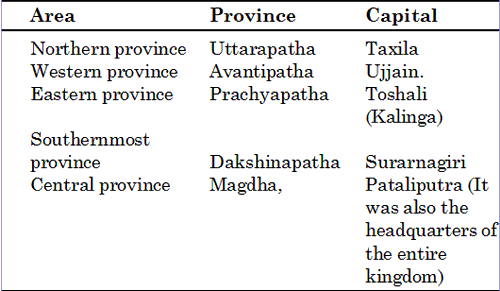
-
Provinces were subdivided into the districts, each of these was further divided into groups of villages and the last unit of administration was the village. The Arthashastra mentions a wide range of scales in salary, the highest being 48,000 papas -and the lowest 60 panas.
Mantri Parishad
The king was assisted by Mantri Parishad, whose members included -
(i) The Yuvaraj, the crown prince
(ii) The Purohita, the chief priest
(iii) The Senapati. the commander-in-chief of the army a few other ministers.
Important Officials
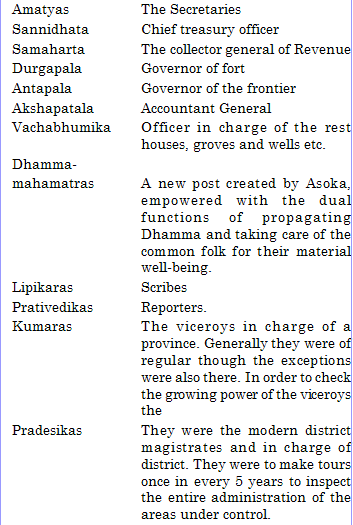
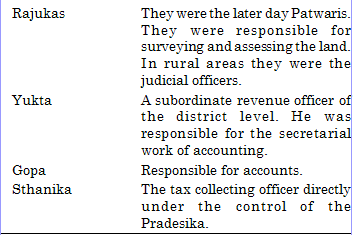
27 Adhyakshas
Some of them are :-
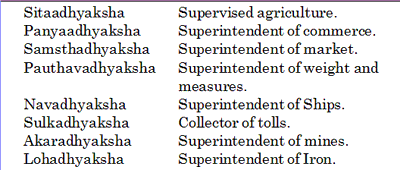
The state controlled almost all economic activities.Tax collected from peasants varied from 5 to 1/6 of the Produce. The state also provided irrigation facilities and charged water-tax. Tolls were also levied on commodities brought to town for sale and they were collected at gate. The slate enjoyed monopoly in mining, sale of liquor, manufacture of arms etc
City Administration
-
A number of cities such as Pataliputra. Taxila, Ujjain. Toshali, Suvarnagiri, Champa, Isila, and Kausambi are mentioned in the edicts of Ashoka. The Arthashastra has a full chapter on the administration of cities. Megasthenese has described in detail the administration of Pataliputra and it can be safely presumed that similar administrative system was followed in most of the Mauryan cities.
-
Megasthenese tells us that the city of Pataliputra was administered by a city council comprising 30 members, which were divided into five members each of six boards. Each of these boards had specific responsibility towards the administration of city.
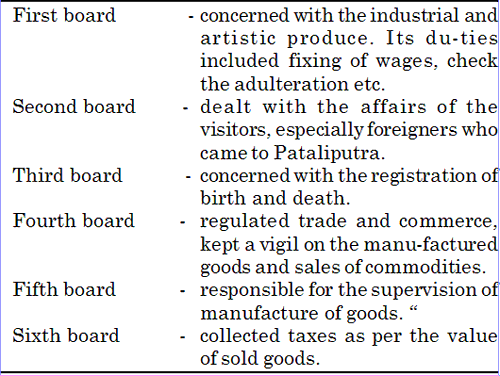
- The officer incharge of the city was known as Nagaraka. The tax was normally one-tenth of the sold goods
Village Administration
Gramika Head of a village. He was generally elected by the people. He was not a paid servant. Gramvriddhas Village elders (To assist the Gramika in his work). Every village had its own Panchayat to settle the disputes. The village was the smallest unit of administration. The head of the village was called gramika who was assisted in village administration by “village elders”. The villages enjoyed considerable autonomy. Most of the disputes of the village were settled by gramika with the help of village assembly.
Army
-
The most striking feature of Mauryan administration was maintanence of a huge army. They also maintained a Navy. According to Megasthenes the administration of Army was carried by a board of 30 officers divided into six committees, each committee consisting of 5 members. They are:
(i) Army
(ii) Cavalry
(iii) Elephants
(iv) Chariots
(v) Navy
(vi) Transport
Society and Culture
-
Megasthenese speaks of Mauryan society as comprising seven castes Megasthenese could not properly comprehend the Indian society and failed to distinguish between jati, Varna and the occupation. Megasthenes’ Division: He mentions seven classes: (a) Philosophers (b) Cultivators (c) Soldiers (d) Herdsmen (e) Artisans (f) Magistates and (g) Councillors. The above division seems to be economic rather than social.
-
The urban way of life developed. The residential accommodation, its wealth etc. were entered into official records and rules and regulation were well defined and strictly implemented.
-
The chaturvarna system continued to govern the society.
-
A married woman had her own property in the form of bride-gift (streedhana) and jewels. These were at her disposal in case of widowhood. The widows had a very honourable place in the society. There are frequent references to women enjoying freedom and engaged in gainful occupation.
-
Megasthenese has stated that slavery did not exist in India. However, forced labour and bonded labour did exist on a very limited scale but were not treated so harshly as the slaves in the western world.
Economy
- Land Revenue: Main source of income; 1/4th to 1/6th of the produce directly collected by the king’s officials.
Industrial Crafts
-
The Mauryan state created a machinery which governed vast areas directly and to enforce the rules and regulations in respect of agriculture, industry, commerce, animal husbandry, etc.
-
The vastness of India’s agricultural and mineral resources and the extraordinary skill of her craftsmen have been mentioned with admiration by Megasthenese and other Greek writers.The state also owned agricultural farms, cattle farms, dairy farms etc.
-
Industry was organised in various guilds. The trade was regulated by the state. “India supplied the western countries with indigo, various medicinal substances, cotton and silk Growth of Crafts: (a) Metallurgy (b) Wood-working (c) Stone-cutting (d) Textile-manufacturing (e) Pottery. The Mauryan State exercise monopoly over certain industrial activities like mining, armour and weaponmaking, brewing of liquor, ship-building etc.
-
Foreign trade was carried on by land as well as by sea. The trade had to get a license to trade. The state controlled and regulated the weights and measures.The chief of a guild was called Jesthaka. The guilds settled the disputes of their members. A few guilds issued their own coins. The guilds also made donations to educational institutions, learned Brahmans and to the destitute.
-
The land tax was one-fourth to one-sixth of the produce. Toll tax was levied on all items which were brought for sale in the market. Tax evasion was considered a very serious crime and offenders were severely punished. The income from the king’s own land or estate was known as sita.
-
Brahmans children and handicapped people were exempted from paying taxes. Also no tax was levied in areas where new trade routes or new irrigation project or new agricultural land were being developed.
-
During Mauryan rule, though there was banking system in India. yet usury was customary and the rate of interest was 15’/’ per annum on borrowing money. In less secure transactions (like sea Voyages etc) the rate of interest could be as high as 60 % per annum. During Mauryan period, the punch marked coins (mostly of silver) were the common units of transactions. Tamralipti m the Gangetic delta was the most prosperous port on the East Coast of India.
Art and Architecture
The main examples of the Mauryan art and architecture that have survived are:
(i) Remains of the royal palaces and the city of Pataliputra
(ii) Ashokan pillars and capitals
(iii) Rock cut Chaitya caves in the Barabar and Nagarjuni hills
(iv) Individual Mauryan sculptures and terracotta figurines
-
The famous city of Pataliputra (modern Patna) was described in detail by Megasthenese, reference of which is found in the writings of Strabo. Arrian and other Greek writers. It was enclosed by a wooden wall and had 64 gates. The Mauryan wooden palace survived for about 700 years because, at the end of the fourth century A.D. when Fa-Hien saw it, it was astounding. The burnt wooden structure and ashes have been found from Kumrahar.
-
The Mauryas introduced stone masonry on large scale. The pillars and the capitals were made of sand stone, near Chunar in Mirzapur district. Fragments of stone pillars and slumps indicating the existence of an 80-pillared hall have been discovered at Kumarhar on outskirts of Patna. The pillars represent the Masterpiece of Mauryan sculpture. Each pillar is made of single piece of sandstone. only their capitals which are beautiful pieces of sculpture in form of lion or bulls are joined with pillar on the top.
- Single Lion capital at Rampurva and Lauriya Nandangarh.
- Single bull capital at Rampurva.
- Four lion capital at Sarnath and Sanchi.
- A carved elephant at Dhauli and engraved elephant at Kalsi.
- Seven rock-cut caves in the Barabar and Nagarjuni hills show that the tradition of rock-cut caves in India began with the Mauryas. These caves were caused to be excavated by Ashoka and his grandson Dasaratha for the abode of Ajivika monks.
- Some Yaksha and Yaskshini figures have been found from Mathura, Pawaya and Patna. They are large sized statues representing folk art of the period. The Yakshi figure from Didarganj, near Patna shows a healthy female figure with fully developed body holding chorine in her hand.
Later Mauryas (232-184 BC)
- Asoka’s death was followed by the divisions of the Mauryan Empire into two parts - Western and Eastern.
-
The western part came to be ruled by Kunala (probably one of the sons of Asoka) and then for a short while by Samprati. It was later threatened by the Bactrian Greeks in the North-west and by the Satava-hanas in the norther Deccan.
-
The eastern part of the empire, with Pataliputra as the capital came to be rules successively by Dasaratha (probably one of the grandsons of Asoka), Samprati (who succeeded both Kunala and Dasaratha in the western and eastern parts respectively), Salisuka, Devavarman, Satadhanvan and finally Brihadratha. The last Mauryan ruler, Brihadratha, was assasinated in 184 BC by his Commanderin-chief, Pushyami-tra Sunga, who established his own Sunga dynasty.
Causes of Decline
The Mauryan Empire lasted a little over a century and broke up fitly years after the death of Asoka. Slowly, the various princes of the empire began to break away and set up independent kingdoms. In 185 BC. the Mauryan king was overthrown by Pushyamitra Shunga, an ambitious Commander-in-Chief of armed forces. He started the Shunga dynasty in Magadha. The Mauryan Empire ushered in a dream that was to survive and echo again and again in centuries to come. Some probable causes of decline of the Mauryan Empire:
- Brahmanical reaction
- Financial crisis
- Oppressive rule
- Neglect of north-west frontier.
- Weak successors
- Pacific policy of Asoka
- New knowledge in outlying areas-Dissemination of knowledge of manufacturing Iron.
